Micellar Parameters of Aqueous Solutions of Tween 20 and 60 at Different Temperatures: Volumetric and Viscometric Study
Abstract
:1. Introduction
2. Experimental Method
2.1. Materials and Methods
2.2. Calculations
3. Results and Discussion
4. Conclusions
Supplementary Materials
Author Contributions
Funding
Acknowledgments
Conflicts of Interest
References
- Mahjoubi, N.; Fazeli, A.; Dinarvand, R.; Khoshayand, M.R.; Shekarchi, M.; Fazelie, M.R. Effect of nonionic surfactants (Dodecyl Maltoside and Polysorbate 20) on prevention of aggregation and conformational changes of recombinant human IFNβ_1b induced by light. Iran J. Pharm. Res. 2017, 16, 103–111. [Google Scholar] [PubMed]
- Martos, A.; Koch, W.; Jiskoot, W.; Wuchner, K.; Winter, G.; Friess, W.; Hawe, A. Trends on analytical characterization of polysorbates and their degradation products in biopharmaceutical formulations. J. Pharm. Sci. 2017, 106, 1722–1735. [Google Scholar] [CrossRef] [PubMed]
- Hall, T.; Sandefur, S.L.; Frye, C.C.; Tuley, T.L.; Huang, L. Polysorbates 20 and 80 degradation by group XV lysosomal phospholipase A 2 isomer X1 in monoclonal antibody formulations. J. Pharm. Sci. 2016, 105, 1633–1642. [Google Scholar] [CrossRef] [PubMed]
- Li, Y.; Hewitt, D.; Lentz, Y.K.; Ji, J.A.; Zhang, T.Y.; Zhang, K. Characterization and stability study of Polysorbate 20 in therapeutic monoclonal antibody formulation by multidimensional ultrahigh-performance liquid chromatography–charged aerosol detection–mass spectrometry. Anal. Chem. 2014, 86, 5150–5157. [Google Scholar] [CrossRef] [PubMed]
- Jiao, J. Polyoxyethylated nonionic surfactants and their applications in topical ocular drug delivery. Adv. Drug Deliv. Rev. 2008, 60, 1663–1673. [Google Scholar] [CrossRef] [PubMed]
- Kerwin, B.A. Polysorbates 20 and 80 used in the formulation of protein biotherapeutics: Structure and degradation pathways. J. Pharm. Sci. 2008, 97, 2924–2935. [Google Scholar] [CrossRef] [PubMed]
- Bosmuler Züge, L.C.; Isidoro Haminiuk, C.W.; Maciel, G.M.; Meira Silveira, J.L.; de PaulaScheer, A. Catastrophic inversion and rheological behavior in soy lecithin and Tween 80 based food emulsions. J. Food Eng. 2013, 116, 72–77. [Google Scholar] [CrossRef]
- Yaghmur, A.; Aserin, A.; Garti, N. Phase behavior of microemulsions based on food-grade nonionic surfactants: Effect of polyols and short-chain alcohols. Colloid Surf. A 2002, 209, 71–81. [Google Scholar] [CrossRef]
- Sugumar, S.; Singh, S.; Mukherjee, A.; Chandrasekaran, N. Nanoemulsion of orange oil with non ionic surfactant produced emulsion using ultrasonication technique: Evaluating against food spoilage yeast. Appl. Nanosci. 2016, 6, 113–120. [Google Scholar] [CrossRef]
- Shah, A.; Tool, P.; Sorathiya, K.; Prajapati, H.; Dalrymole, D.; Serajuddin, A.T.M. Effect of different polysorbates on development of self-microemulsifying drug delivery systems using medium chain lipids. Drug Dev. Ind. Pharm. 2018, 44, 215–223. [Google Scholar] [CrossRef] [PubMed]
- Torres, L.G.; Rojas, N.; Iturbe, R. Use of two-surfactants mixtures to attain specific HLB values for assisted TPH-diesel biodegradation. J. Environ. Sci. 2004, 16, 950–956. [Google Scholar]
- O’Sullivan, S.M.; Woods, J.A.; O’Brien, N.M. Use of Tween 40 and Tween 80 to deliver a mixture of phytochemicals to human colonic adenocarcinoma cell (CaCo-2) monolayers. Br. J. Nutr. 2004, 91, 757–764. [Google Scholar] [CrossRef] [PubMed] [Green Version]
- Losada-Barreiro, S.; Sánchez-Paz, V.; Bravo-Díaz, C. Effects of emulsifier hydrophile-lipophile balance and emulsifier concentration on the distributions of gallic acid, propyl gallate, and α-tocopherol in corn oil emulsions. J. Colloid Interface Sci. 2013, 389, 1–9. [Google Scholar] [CrossRef] [PubMed]
- Rosen, J.M. Surfactants and Interfacial Phenomena, 3rd ed.; Wiley Interscience: New York, NY, USA, 2004. [Google Scholar]
- Schick, M.J. Nonionic Surfactants, Physical Chemistry, Surfactant Science Series; Marcel Dekker, Inc.: New York, NY, USA, 1987. [Google Scholar]
- Williams, H.D.; Trevaskis, N.L.; Charman, S.A.; Shanker, R.M.; Charman, W.N.; Pouton, C.W.; Porter, C.J.H. Strategies to address low drug solubility in discovery and development. Pharmacol. Rev. 2013, 65, 315–499. [Google Scholar] [CrossRef] [PubMed]
- Florence, A.T.; Hussain, N. Transcytosis of nanoparticle and dendrimer delivery systems: Evolving vistas. Adv. Drug Deliv. Rev. 2001, 50, 569–589. [Google Scholar] [CrossRef]
- Meena, J.; Singh, M. Hydrophobics and double bond of Tweens affecting water interactions estimated with physicochemical properties at T = 298.15 K. J. Mol. Liq. 2013, 220, 671–680. [Google Scholar] [CrossRef]
- Sannaningannavar, F.M.; Patil, S.N.; Melavanki, R.M.; Navati, B.S.; Ayachit, N.H. Thermodynamic parameters and their dependence on temperature in the range 298–353 K for ethoxylated sorbitan ester tween 20, 40, 60 and 80 surfactants. J. Surfactants Deterg. 2015, 18, 495–504. [Google Scholar] [CrossRef]
- Glenn, K.M.; Moroze, S.; Bhattacharya, S.C.; Palepu, R.M. Effect of ethylene glycol on the thermodynamic and micellar properties of Tween 40, 60, and 80. J. Dispers. Sci. Technol. 2005, 26, 79–86. [Google Scholar] [CrossRef]
- Hait, S.K.; Moulik, S.P. Determination of critical micelle concentration (CMC) of nonionic surfactants by donor-acceptor interaction with lodine and correlation of CMC with hydrophile-lipophile balance and other parameters of the surfactants. J. Surfactants Deterg. 2001, 4, 303–309. [Google Scholar] [CrossRef]
- Carnero Ruiz, C.; Molina-Bolıávar, J.A.; Aguiar, J.; MacIsaac, G.; Moroze, S.; Palepu, R. Effect of ethylene glycol on the thermodynamic and micellar properties of Tween 20. Colloid Polym. Sci. 2003, 281, 531–541. [Google Scholar] [CrossRef]
- Chauhan, S.; Sharma, K. Extended studies on molecular interactions of SDBS and DTAB in aqueous solutions of amino acid at T = 293.15–313.15 K. J. Mol. Liq. 2015, 211, 675–685. [Google Scholar] [CrossRef]
- Kiełek, K.; Marczak, W. Hydration of non-electrolytes in H2O and D2O investigated by Passynski’s method. Int. J. Thermophys. 2010, 31, 77–84. [Google Scholar] [CrossRef]
- Singh, T.; Kumar, A. Thermodynamics of dilute aqueous solutions of imidazolium based ionic liquids. J. Chem. Thermodyn. 2011, 43, 958–965. [Google Scholar] [CrossRef]
- Burakowski, A.; Gliński, J. Hydration numbers of non-electrolytes—Application of the acoustic method of Pasynski. Chem. Phys. 2007, 332, 336–340. [Google Scholar] [CrossRef]
- Sannaningannavar, F.M.; Navati, B.S.; Ayachit, N.H. Studies on thermo-acoustic parameters of poly(ethylene glycol)-400 at different temperatures. J. Therm. Anal. Calorim. 2013, 112, 1573–1578. [Google Scholar] [CrossRef]
- Gautam, P.K.; Gautam, R.K.; Rai, R.; Pandey, J.D. Thermodynamic and transport properties of sodium dodecylbenzenesulphonate (SDBS) in aqueous medium over the temperature range 298.15 K to 333.15 K. J. Mol. Liq. 2014, 191, 107–110. [Google Scholar] [CrossRef]
- Boden, N.; Corne, S.A.; Jolley, K.W. Lyotropic mesomorphism of the cesium pentadecafluorooctanoate/water system: High-resolution phase diagram. J. Phys. Chem. 1987, 1, 4092–4105. [Google Scholar] [CrossRef]
- Benjamin, L. Partial molal volume changes during micellization and solution of nonionic surfactants and perfluorocarboxylates using a magnetic density balance. J. Phys. Chem. 1966, 70, 3790–3797. [Google Scholar] [CrossRef]
- Sunil Babu, K.; Venkateswara Rao, A.; Madhavi Latha, D.; Pardhasaradhi, P.; Pisipati, V.G.K.M. Estimation of thermodynamic parameters in 4-(hexyloxybenzylidene)-4′alkoxy anilines, 6O·Om liquid crystalline compounds—A density study. J. Mol. Liq. 2016, 220, 999–1003. [Google Scholar] [CrossRef]
- Venkata Rao, D.; Pardhasaradhi, P.; Pisipati, V.G.K.M.; Madhavi Latha, D.; Datta Prasad, P.V. Estimation of thermodynamic parameters in 3.Om and 3O.Om liquid crystalline compounds. J. Mol. Liq. 2015, 211, 90–95. [Google Scholar] [CrossRef]
- Reddy, R.R.; Rama Gopal, K.; Narasimhulu, K.; Siva Sankara Reddy, L.; Raghavendra Kumar, K.; Venkatesulu, A.; Krishna Reddy, C.V. Correlations between Moelwyn–Hughes parameter, available volume and intermolecular free-lengths in liquid systems. J. Mol. Liq. 2008, 140, 48–53. [Google Scholar] [CrossRef]
- Sannaningannavar, F.M.; Patil, S.N.; Navati, B.S.; Melavanki, R.M.; Ayachit, N.H. Studies on thermodynamic properties of pure poly(ethylene glycol)-400 in the temperature range 299–363 K using volume expansivities. Polym. Bull. 2013, 70, 3171–3183. [Google Scholar] [CrossRef]
- Subrahmanyam, M.S.R.; Vedanayagam, H.S.; Venkateshwar, R.D.; Rajaiah, A.; Venkatacharyulu, P. Estimation of Sharma constant and thermoacoustic properties of fatty acids. J. Am. Oil Chem. Soc. 1995, 72, 1537–1540. [Google Scholar] [CrossRef]
- Huang, J.; Zhang, S.; Feng, Y.; Li, J.; Yan, H.; He, F.; Wang, G.; Liu, Y.; Wang, L. Rheological properties and application of wormlike micelles formed by sodium oleate/benzyltrimethyl ammonium bromide. Colloid Surf. A 2016, 500, 222–229. [Google Scholar] [CrossRef]
- Kumar, R.; Mahesh, R.; Shanmugapriyan, B.; Kannappan, V. Volumetric, viscometric, acoustic and refractometric studies of molecular interactions in certain binarysystems of o-chlorophenol at 303.15 K. Indian J. Pure Appl. Phys. 2012, 50, 633–640. [Google Scholar]
- Chauhan, S.; Kumar, K.; Patial, B.S. Study of acoustical parameters f proline in lecithin–ethanol mixture at varying temperature. Indian J. Pure Appl. Phys. 2013, 51, 531–541. [Google Scholar]
- Szymczyk, K.; Taraba, A. Aggregation behavior of Triton X-114 and Tween 80 at various temperatures and concentrations studied by density and viscosity measurements. J. Therm. Anal. Calorim. 2016, 126, 315–326. [Google Scholar] [CrossRef]
- Jones, G.; Dole, M. The viscosity of aqueous solutions of strong electrolytes with special reference to barium chloride. J. Am. Chem. Soc. 1929, 51, 2950–2964. [Google Scholar] [CrossRef]
- Ali, A.; Hyder, S.; Akhtar, Y. Viscometric studies of a-amino acid in aqueous NaCl and MgCl2 at 303 K. Indian J. Phys. 2005, 79, 157–160. [Google Scholar]
- Huque, M.; Siddiquey, I.A.; Uddin, N. Volumetric and viscometric studies on dodecyltrimethylammonium bromide in aqueous and in aqueous amino acid solutions in premicellar region. J. Chem. Thermodyn. 2006, 38, 1474–1478. [Google Scholar] [CrossRef]
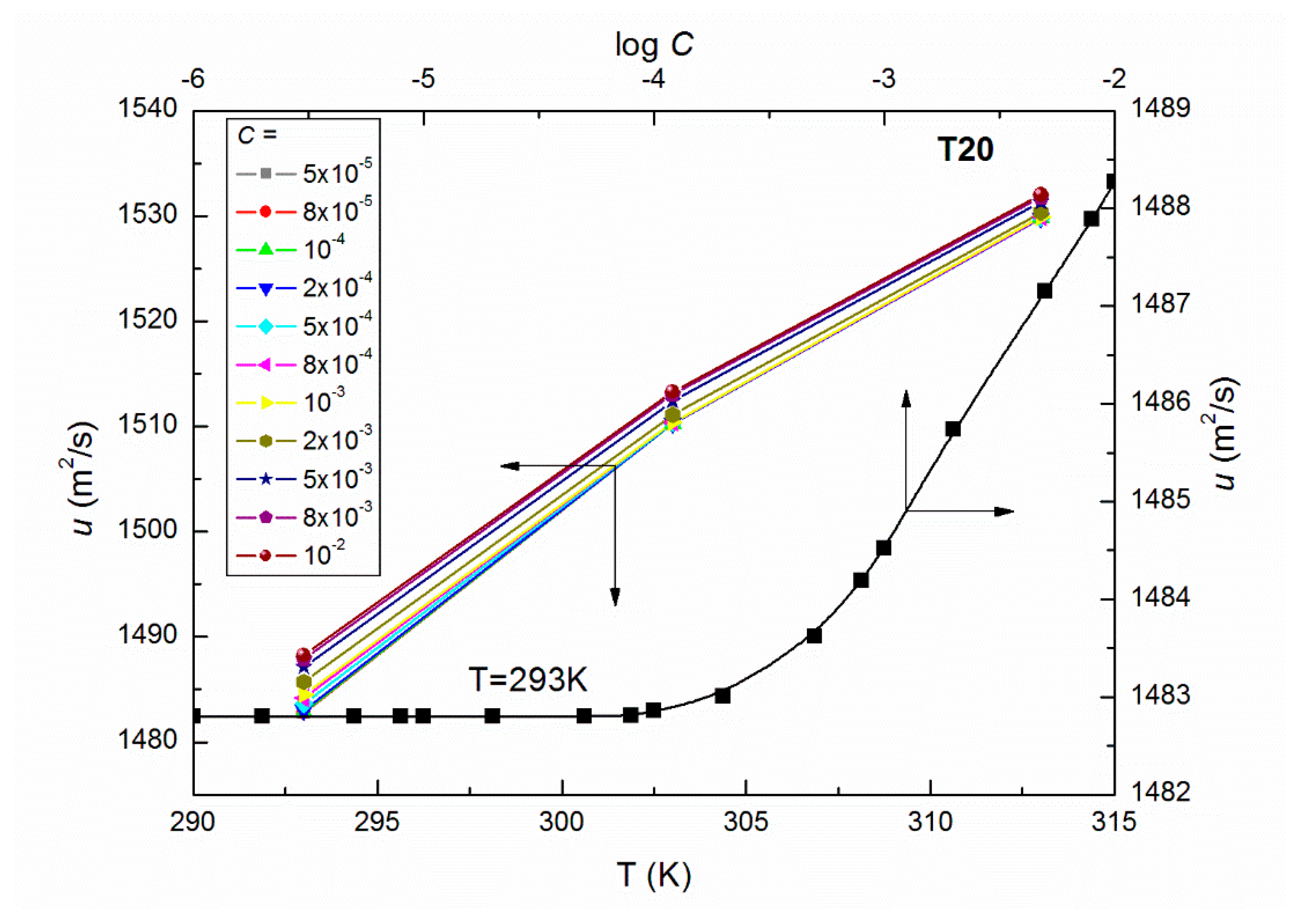
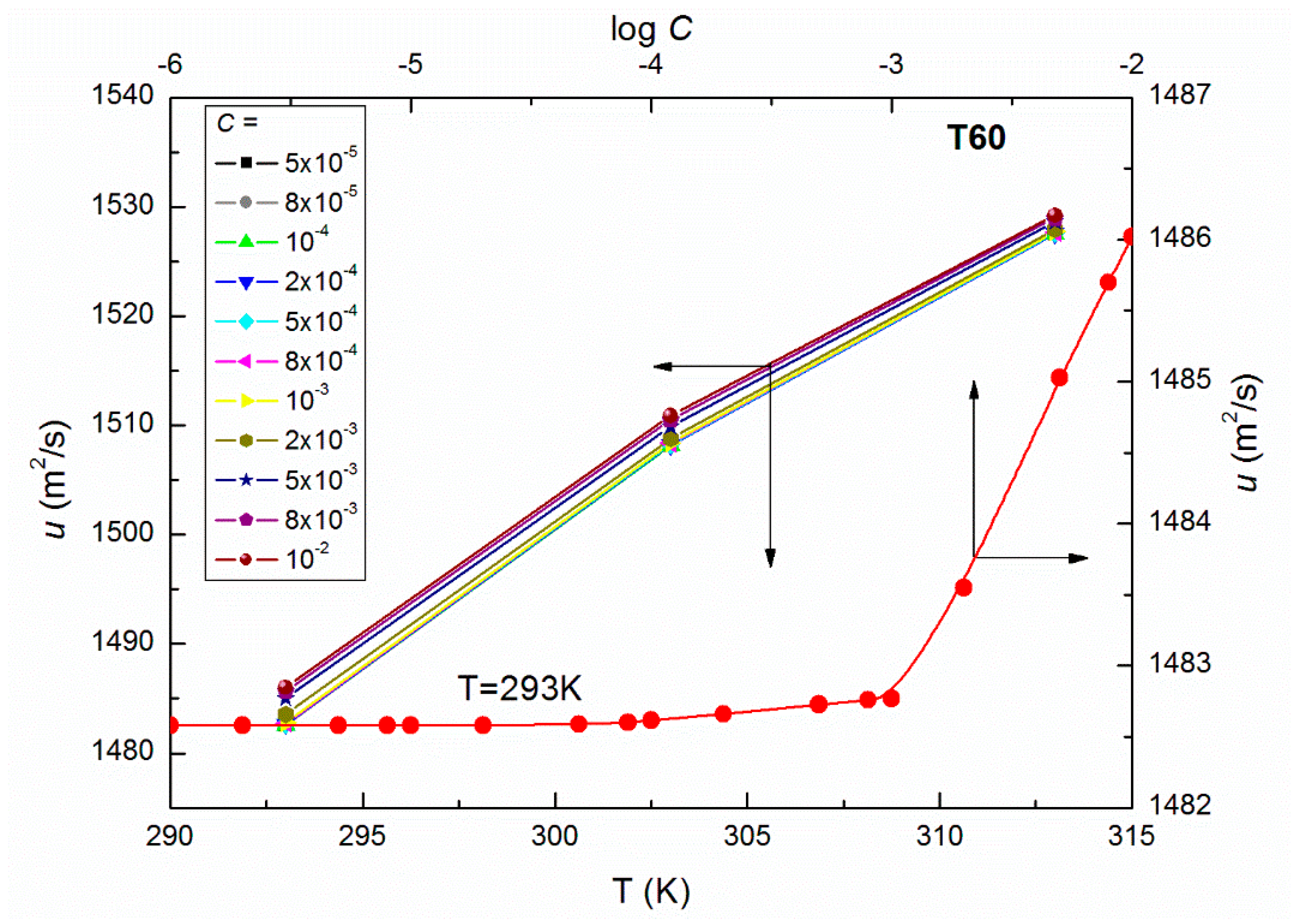
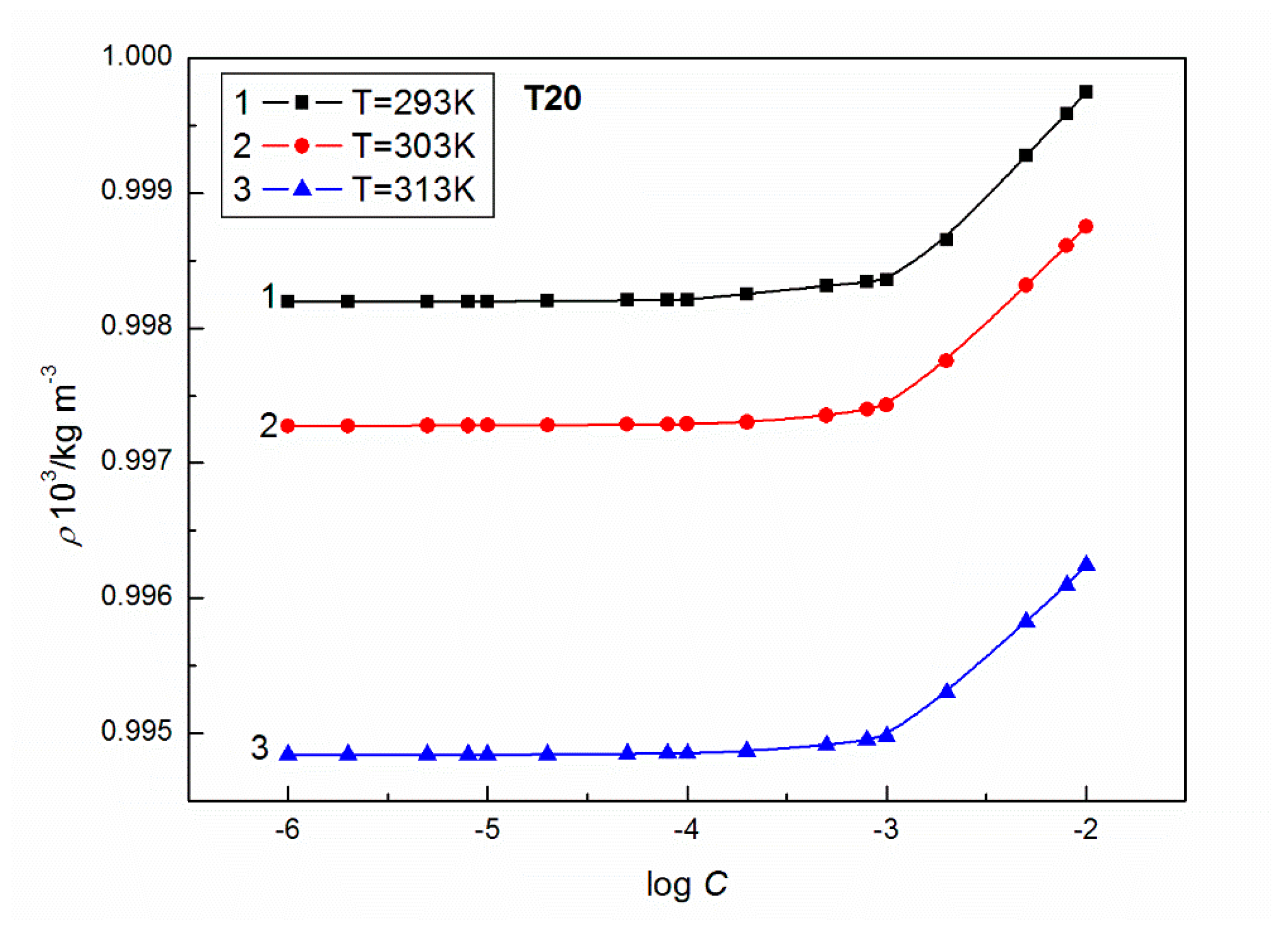
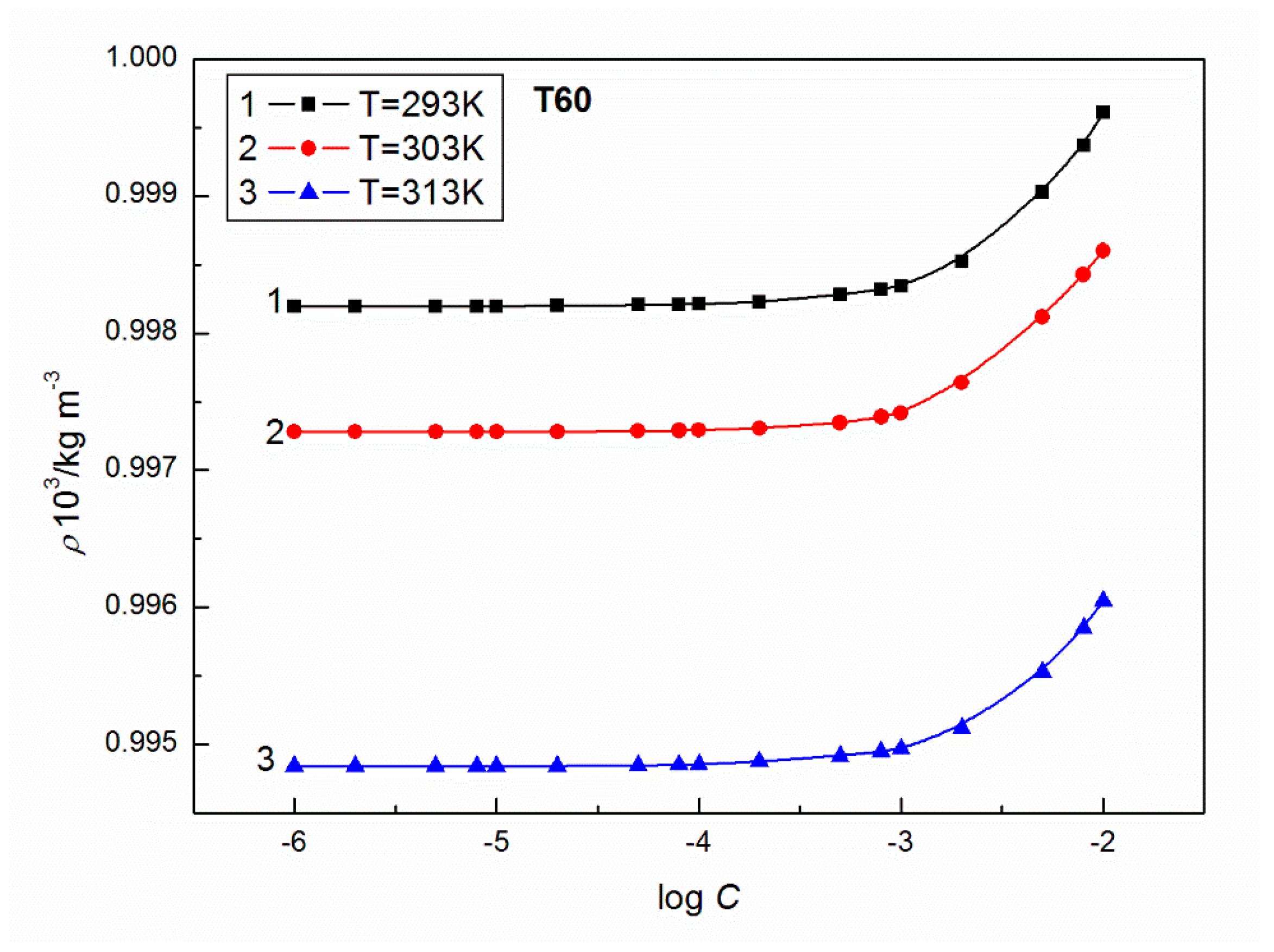
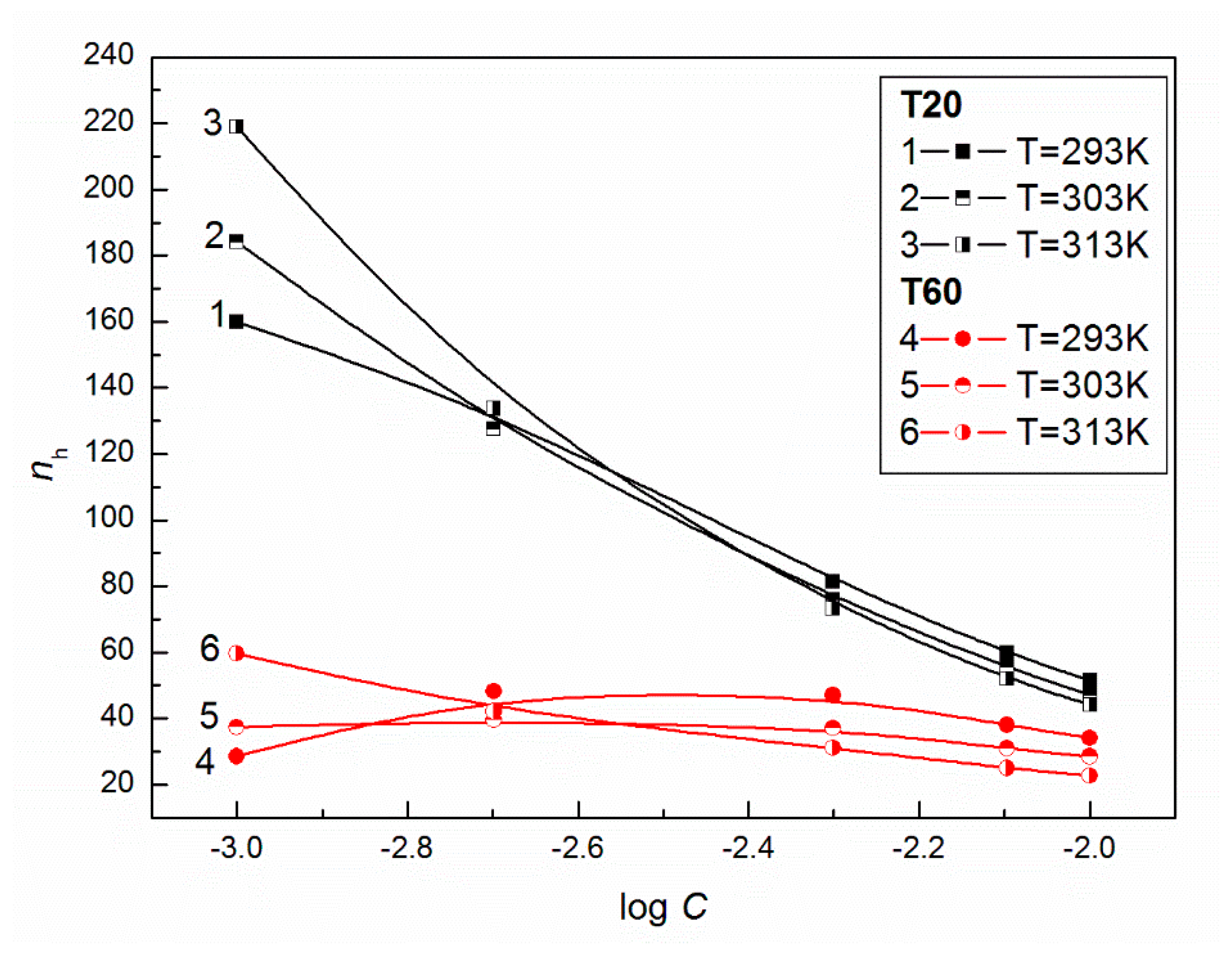
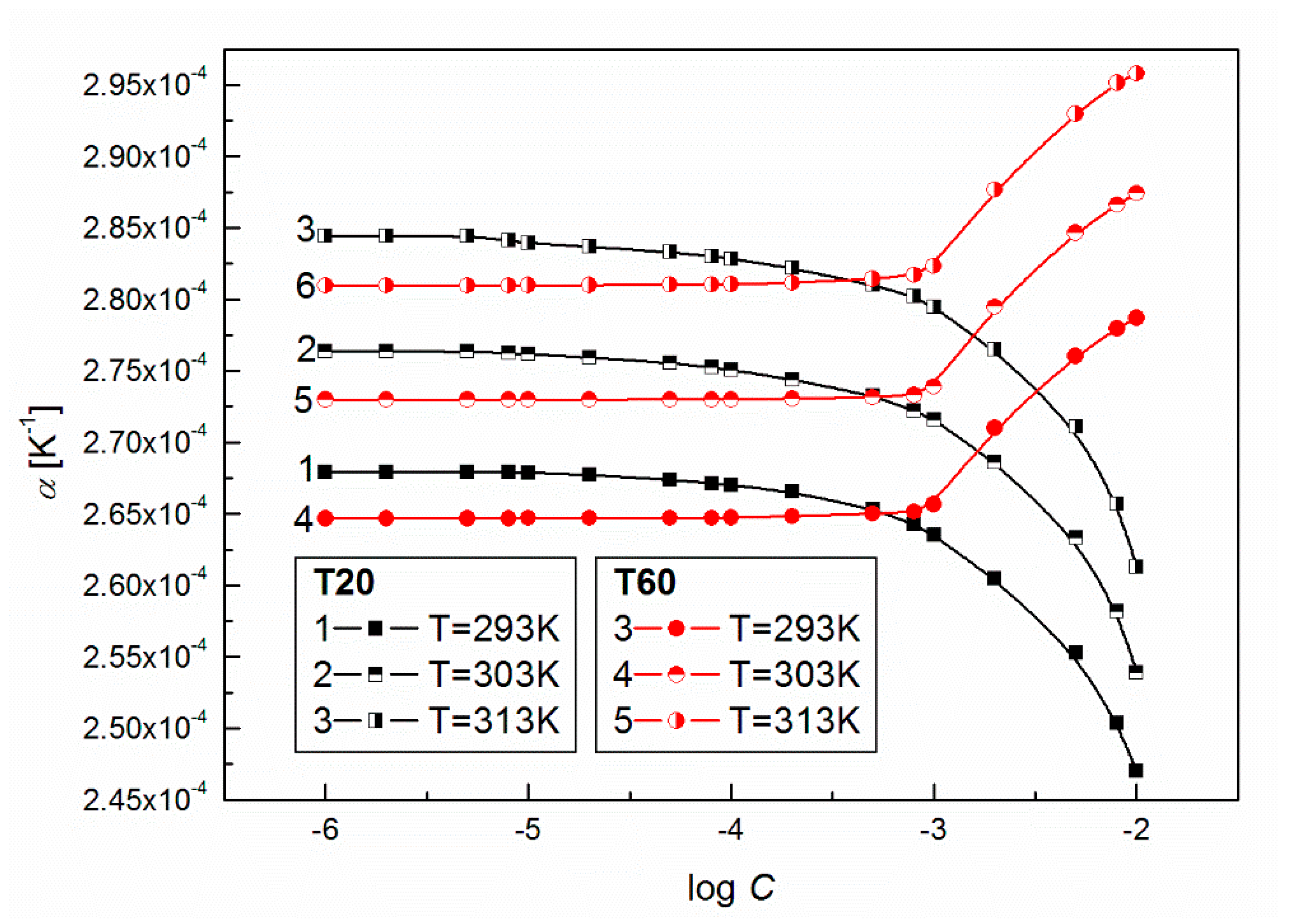
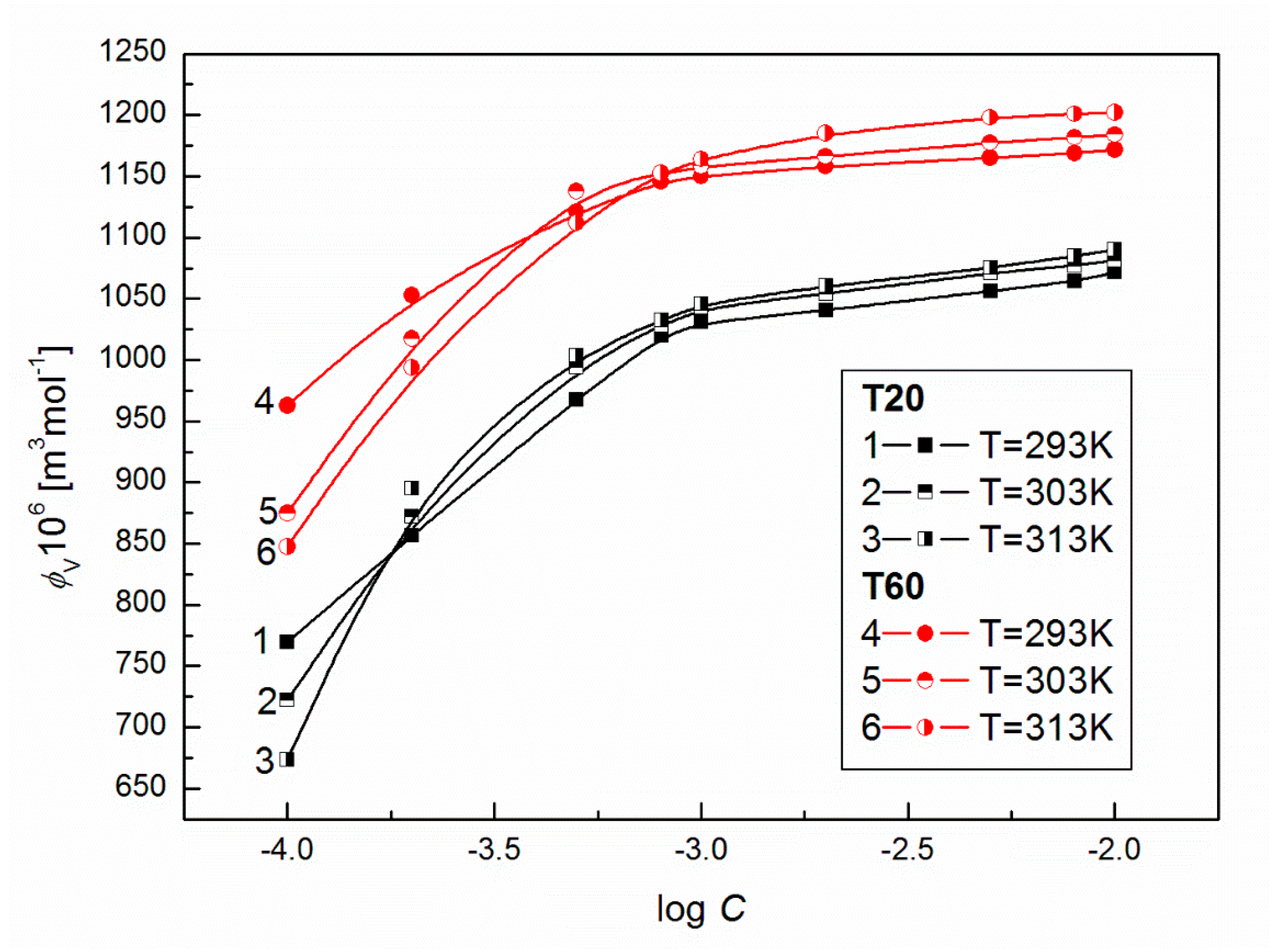
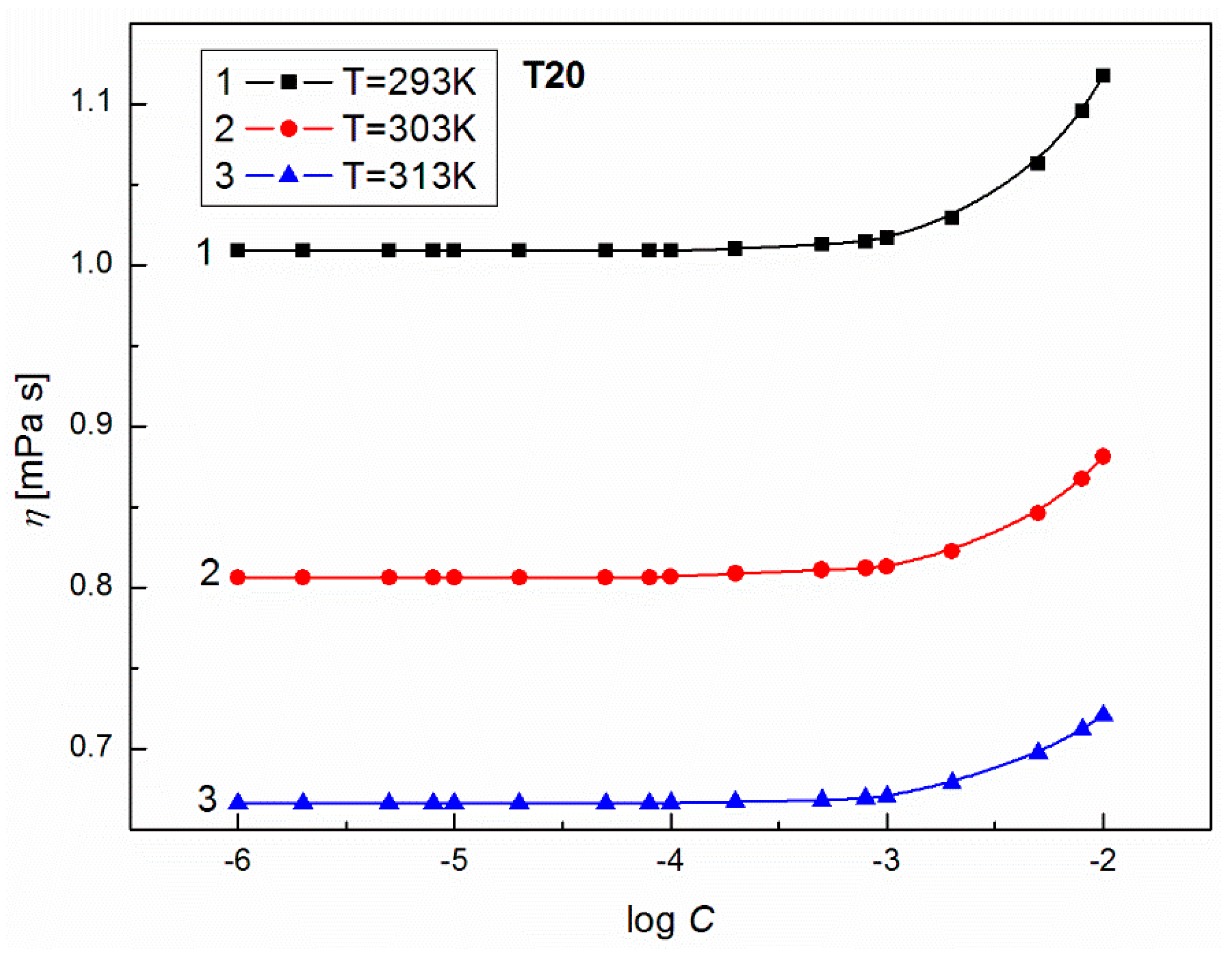
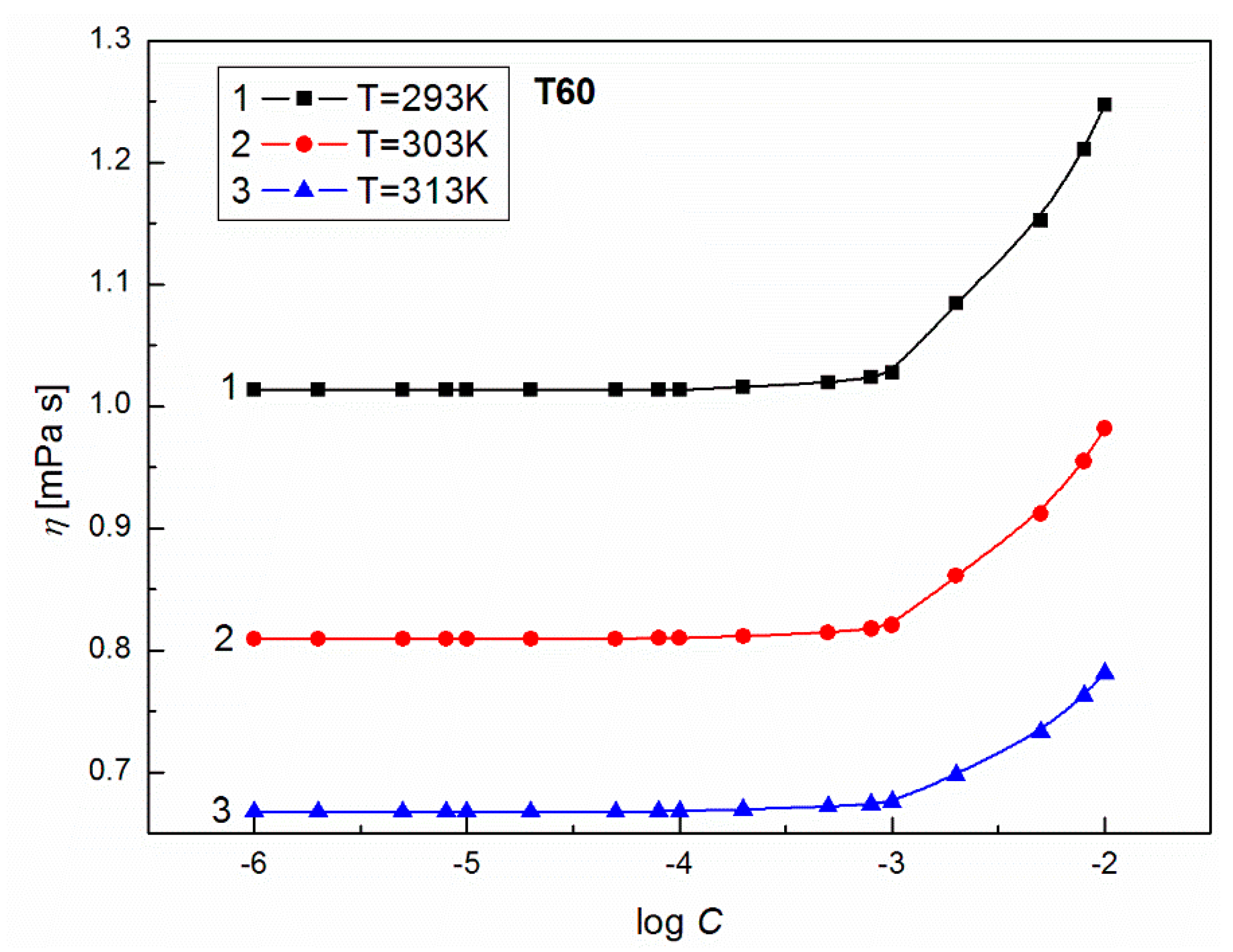

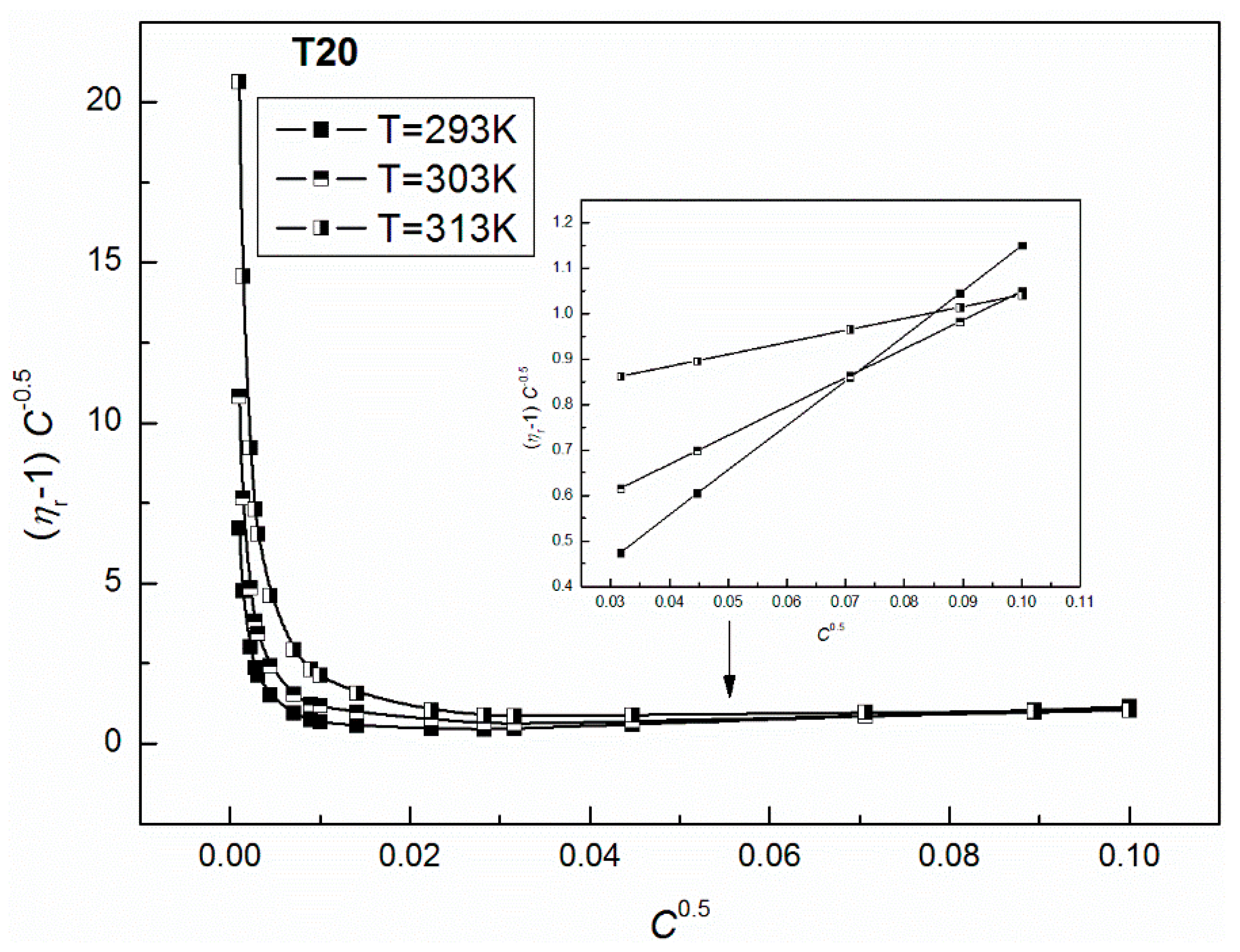

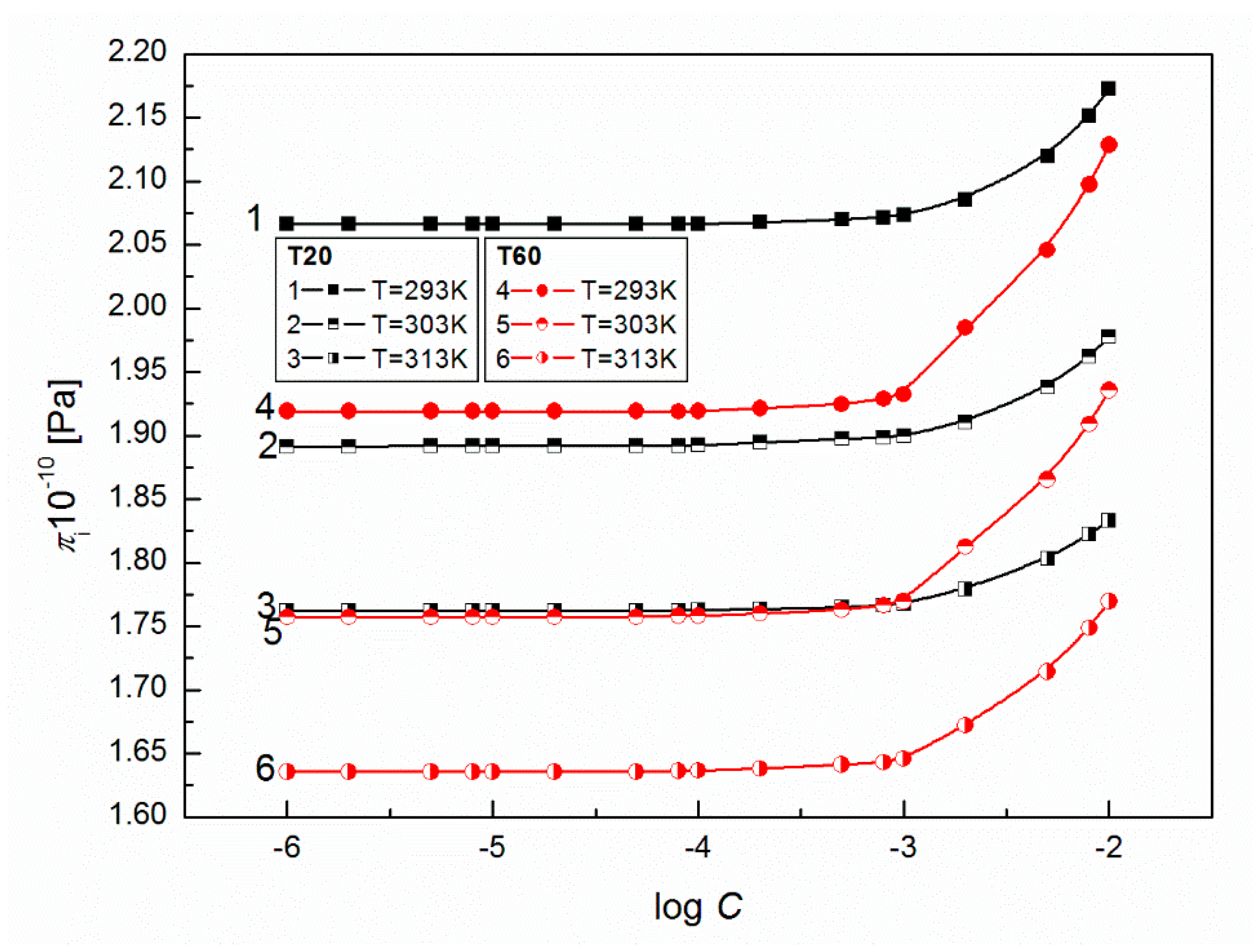
| T20 | ||||||
|---|---|---|---|---|---|---|
| C | 10−10 m2 N−1 | 10−10m | 106 kg m−2 s−1 | 10−6 m3 mol−1 | 10−4 m10/3 s−1/3 mol−1 | |
| T = 293 K | 10−6 | 4.5564 | 0.4349 | 1.4801 | 29.3530 | 45.6842 |
| 2 × 10−6 | 4.5564 | 0.4349 | 1.4801 | 29.3530 | 45.6842 | |
| 5 × 10−6 | 4.5564 | 0.4349 | 1.4801 | 29.3530 | 45.6842 | |
| 8 × 10−6 | 4.5564 | 0.4349 | 1.4801 | 29.3530 | 45.6842 | |
| 10−5 | 4.5564 | 0.4349 | 1.4801 | 29.3529 | 45.6842 | |
| 2 × 10−5 | 4.5564 | 0.4349 | 1.4801 | 29.3529 | 45.6840 | |
| 5 × 10−5 | 4.5563 | 0.4349 | 1.4801 | 29.3527 | 45.6838 | |
| 8 × 10−5 | 4.5563 | 0.4349 | 1.4802 | 29.3501 | 45.6838 | |
| 10−4 | 4.5560 | 0.4349 | 1.4802 | 29.3385 | 45.6842 | |
| 2 × 10−4 | 4.5548 | 0.4348 | 1.4804 | 29.2989 | 45.6837 | |
| 5 × 10−4 | 4.5508 | 0.4347 | 1.4811 | 29.1447 | 45.6873 | |
| 8 × 10−4 | 4.5472 | 0.4345 | 1.4817 | 28.9999 | 45.6919 | |
| 10−3 | 4.5451 | 0.4344 | 1.4821 | 28.9176 | 45.6947 | |
| 2 × 10−3 | 4.5363 | 0.4340 | 1.4837 | 28.6050 | 45.6933 | |
| 5 × 10−3 | 4.5248 | 0.4334 | 1.4861 | 28.2319 | 45.6794 | |
| 8 × 10−3 | 4.5190 | 0.4331 | 1.4873 | 28.0392 | 45.6729 | |
| 10−2 | 4.5159 | 0.4330 | 1.4879 | 27.9396 | 45.6694 | |
| T = 303 K | 10−6 | 4.3962 | 0.4351 | 1.5061 | 22.4963 | 46.0069 |
| 2 × 10−6 | 4.3962 | 0.4351 | 1.5061 | 22.4963 | 46.0069 | |
| 5 × 10−6 | 4.3962 | 0.4351 | 1.5061 | 22.4962 | 46.0068 | |
| 8 × 10−6 | 4.3962 | 0.4351 | 1.5062 | 22.4962 | 46.0067 | |
| 10−5 | 4.3962 | 0.4351 | 1.5062 | 22.4962 | 46.0067 | |
| 2 × 10−5 | 4.3962 | 0.4351 | 1.5062 | 22.4961 | 46.0066 | |
| 5 × 10−5 | 4.3962 | 0.4351 | 1.5062 | 22.4961 | 46.0064 | |
| 8 × 10−5 | 4.3962 | 0.4351 | 1.5062 | 22.4960 | 46.0063 | |
| 10−4 | 4.3962 | 0.4351 | 1.5062 | 22.4955 | 46.0062 | |
| 2 × 10−4 | 4.3960 | 0.4351 | 1.5062 | 22.4902 | 46.0059 | |
| 5 × 10−4 | 4.3954 | 0.4350 | 1.5063 | 22.4748 | 46.0042 | |
| 8 × 10−4 | 4.3950 | 0.4350 | 1.5064 | 22.4647 | 46.0024 | |
| 10−3 | 4.3948 | 0.4350 | 1.5065 | 22.4603 | 46.0012 | |
| 2 × 10−3 | 4.3892 | 0.4347 | 1.5077 | 22.2725 | 45.9933 | |
| 5 × 10−3 | 4.3793 | 0.4342 | 1.5098 | 21.9379 | 45.9806 | |
| 8 × 10−3 | 4.3742 | 0.4340 | 1.5109 | 21.7671 | 45.9738 | |
| 10−2 | 4.3720 | 0.4339 | 1.5114 | 21.6971 | 45.9700 | |
| T = 313 K | 10−6 | 4.2951 | 0.4378 | 1.5219 | 17.6385 | 46.3175 |
| 2 × 10−6 | 4.2951 | 0.4378 | 1.5219 | 17.6385 | 46.3175 | |
| 5 × 10−6 | 4.2951 | 0.4378 | 1.5219 | 17.6385 | 46.3175 | |
| 8 × 10−6 | 4.2951 | 0.4378 | 1.5219 | 17.6385 | 46.3175 | |
| 10−5 | 4.2951 | 0.4378 | 1.5219 | 17.6385 | 46.3175 | |
| 2 × 10−5 | 4.2951 | 0.4378 | 1.5219 | 17.6384 | 46.3174 | |
| 5 × 10−5 | 4.2950 | 0.4378 | 1.5219 | 17.6383 | 46.3172 | |
| 8 × 10−5 | 4.2950 | 0.4378 | 1.5219 | 17.6383 | 46.3170 | |
| 10−4 | 4.2950 | 0.4378 | 1.5219 | 17.6378 | 46.3170 | |
| 2 × 10−4 | 4.2949 | 0.4378 | 1.5220 | 17.6332 | 46.3165 | |
| 5 × 10−4 | 4.2945 | 0.4378 | 1.5221 | 17.6244 | 46.3147 | |
| 8 × 10−4 | 4.2941 | 0.4378 | 1.5222 | 17.6157 | 46.3132 | |
| 10−3 | 4.2939 | 0.4377 | 1.5222 | 17.6109 | 46.3120 | |
| 2 × 10−3 | 4.2901 | 0.4376 | 1.5232 | 17.4972 | 46.3014 | |
| 5 × 10−3 | 4.2824 | 0.4372 | 1.5249 | 17.2449 | 46.2868 | |
| 8 × 10−3 | 4.2785 | 0.4370 | 1.5258 | 17.1173 | 46.2792 | |
| 10−2 | 4.2767 | 0.4369 | 1.5263 | 17.0591 | 46.2746 | |
| T60 | ||||||
|---|---|---|---|---|---|---|
| C | 10−10 m2 N−1 | 10−10 m | 106 kg m−2 s−1 | 10−6 m3 mol−1 | 10−4 m10/3 s−1/3 mol−1 | |
| T = 293 K | 10−6 | 4.5577 | 0.4350 | 1.4799 | 29.4081 | 45.6819 |
| 2 × 10−6 | 4.5577 | 0.4350 | 1.4799 | 29.4081 | 45.6819 | |
| 5 × 10−6 | 4.5577 | 0.4350 | 1.4799 | 29.4081 | 45.6819 | |
| 8 × 10−6 | 4.5577 | 0.4350 | 1.4799 | 29.4080 | 45.6819 | |
| 10−5 | 4.5577 | 0.4350 | 1.4799 | 29.4080 | 45.6819 | |
| 2 × 10−5 | 4.5577 | 0.4350 | 1.4799 | 29.4077 | 45.6819 | |
| 5 × 10−5 | 4.5576 | 0.4350 | 1.4799 | 29.4053 | 45.6817 | |
| 8 × 10−5 | 4.5575 | 0.4350 | 1.4799 | 29.4022 | 45.6816 | |
| 10−4 | 4.5574 | 0.4350 | 1.4800 | 29.3985 | 45.6815 | |
| 2 × 10−4 | 4.5571 | 0.4350 | 1.4800 | 29.3869 | 45.6814 | |
| 5 × 10−4 | 4.5564 | 0.4349 | 1.4802 | 29.3687 | 45.6796 | |
| 8 × 10−4 | 4.5561 | 0.4349 | 1.4803 | 29.3594 | 45.6782 | |
| 10−3 | 4.5559 | 0.4349 | 1.4803 | 29.3561 | 45.6771 | |
| 2 × 10−3 | 4.5503 | 0.4346 | 1.4814 | 29.1559 | 45.6771 | |
| 5 × 10−3 | 4.5389 | 0.4341 | 1.4836 | 28.7711 | 45.6689 | |
| 8 × 10−3 | 4.5333 | 0.4338 | 1.4848 | 28.5935 | 45.6602 | |
| 10−2 | 4.5302 | 0.4337 | 1.4854 | 28.5062 | 45.6527 | |
| T = 303 K | 10−6 | 4.4084 | 0.4357 | 1.5041 | 23.0176 | 45.9855 |
| 2 × 10−6 | 4.4084 | 0.4357 | 1.5041 | 23.0176 | 45.9855 | |
| 5 × 10−6 | 4.4084 | 0.4357 | 1.5041 | 23.0176 | 45.9855 | |
| 8 × 10−6 | 4.4084 | 0.4357 | 1.5041 | 23.0176 | 45.9855 | |
| 10−5 | 4.4084 | 0.4357 | 1.5041 | 23.0176 | 45.9855 | |
| 2 × 10−5 | 4.4083 | 0.4357 | 1.5041 | 23.0175 | 45.9855 | |
| 5 × 10−5 | 4.4083 | 0.4357 | 1.5041 | 23.0164 | 45.9853 | |
| 8 × 10−5 | 4.4082 | 0.4357 | 1.5041 | 23.0141 | 45.9852 | |
| 10−4 | 4.4082 | 0.4357 | 1.5041 | 23.0123 | 45.9852 | |
| 2 × 10−4 | 4.4079 | 0.4356 | 1.5042 | 23.0035 | 45.9849 | |
| 5 × 10−4 | 4.4073 | 0.4356 | 1.5043 | 22.9833 | 45.9839 | |
| 8 × 10−4 | 4.4068 | 0.4356 | 1.5044 | 22.9681 | 45.9824 | |
| 10−3 | 4.4065 | 0.4356 | 1.5045 | 22.9593 | 45.9814 | |
| 2 × 10−3 | 4.4032 | 0.4354 | 1.5052 | 22.8545 | 45.9752 | |
| 5 × 10−3 | 4.3947 | 0.4350 | 1.5070 | 22.5707 | 45.9643 | |
| 8 × 10−3 | 4.3898 | 0.4347 | 1.5081 | 22.4100 | 45.9563 | |
| 10−2 | 4.3868 | 0.4346 | 1.5088 | 22.3112 | 45.9521 | |
| T = 313 K | 10−6 | 4.3078 | 0.4385 | 1.5197 | 18.2064 | 46.2947 |
| 2 × 10−6 | 4.3078 | 0.4385 | 1.5197 | 18.2064 | 46.2947 | |
| 5 × 10−6 | 4.3078 | 0.4385 | 1.5197 | 18.2064 | 46.2947 | |
| 8 × 10−6 | 4.3078 | 0.4385 | 1.5197 | 18.2064 | 46.2947 | |
| 10−5 | 4.3078 | 0.4385 | 1.5197 | 18.2064 | 46.2947 | |
| 2 × 10−5 | 4.3078 | 0.4385 | 1.5197 | 18.2064 | 46.2946 | |
| 5 × 10−5 | 4.3078 | 0.4385 | 1.5197 | 18.2060 | 46.2944 | |
| 8 × 10−5 | 4.3077 | 0.4385 | 1.5197 | 18.2056 | 46.2942 | |
| 10−4 | 4.3077 | 0.4384 | 1.5197 | 18.2049 | 46.2941 | |
| 2 × 10−4 | 4.3075 | 0.4384 | 1.5198 | 18.1985 | 46.2934 | |
| 5 × 10−4 | 4.3069 | 0.4384 | 1.5199 | 18.1811 | 46.2921 | |
| 8 × 10−4 | 4.3065 | 0.4384 | 1.5200 | 18.1680 | 46.2912 | |
| 10−3 | 4.3063 | 0.4384 | 1.5200 | 18.1613 | 46.2904 | |
| 2 × 10−3 | 4.3044 | 0.4383 | 1.5205 | 18.1025 | 46.2856 | |
| 5 × 10−3 | 4.2988 | 0.4380 | 1.5218 | 17.9276 | 46.2734 | |
| 8 × 10−3 | 4.2954 | 0.4378 | 1.5226 | 17.8280 | 46.2623 | |
| 10−2 | 4.2933 | 0.4377 | 1.5232 | 17.7702 | 46.2552 | |
© 2018 by the authors. Licensee MDPI, Basel, Switzerland. This article is an open access article distributed under the terms and conditions of the Creative Commons Attribution (CC BY) license (http://creativecommons.org/licenses/by/4.0/).
Share and Cite
Szymczyk, K.; Szaniawska, M.; Taraba, A. Micellar Parameters of Aqueous Solutions of Tween 20 and 60 at Different Temperatures: Volumetric and Viscometric Study. Colloids Interfaces 2018, 2, 34. https://doi.org/10.3390/colloids2030034
Szymczyk K, Szaniawska M, Taraba A. Micellar Parameters of Aqueous Solutions of Tween 20 and 60 at Different Temperatures: Volumetric and Viscometric Study. Colloids and Interfaces. 2018; 2(3):34. https://doi.org/10.3390/colloids2030034
Chicago/Turabian StyleSzymczyk, Katarzyna, Magdalena Szaniawska, and Anna Taraba. 2018. "Micellar Parameters of Aqueous Solutions of Tween 20 and 60 at Different Temperatures: Volumetric and Viscometric Study" Colloids and Interfaces 2, no. 3: 34. https://doi.org/10.3390/colloids2030034




